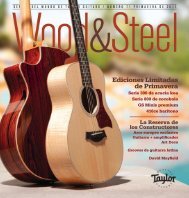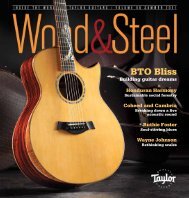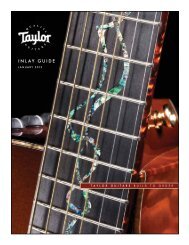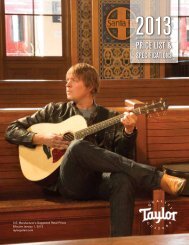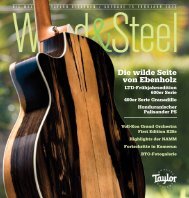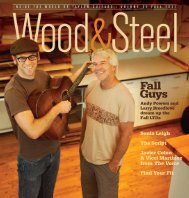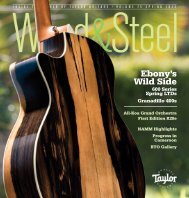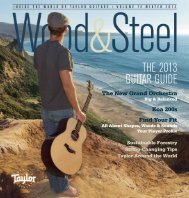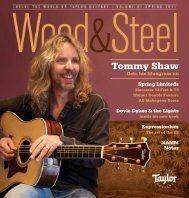Taylor 710 CE-L9 Short-Scale Dreadnought - Taylor Guitars
Taylor 710 CE-L9 Short-Scale Dreadnought - Taylor Guitars
Taylor 710 CE-L9 Short-Scale Dreadnought - Taylor Guitars
You also want an ePaper? Increase the reach of your titles
YUMPU automatically turns print PDFs into web optimized ePapers that Google loves.
new gear<br />
<strong>Taylor</strong> <strong>710</strong> <strong>CE</strong>-<strong>L9</strong> <strong>Short</strong>-<strong>Scale</strong><br />
<strong>Dreadnought</strong><br />
A versatile hybrid charmer with vintage-dreadnought whomp,<br />
short-scale playability, and state-of-the-art onboard electronics.<br />
by Scott Nygaard<br />
For many of us who discovered the guitar in the<br />
1960s and early ’70s, the Martin D-28 defined the<br />
sound of an acoustic guitar. For bluegrass<br />
flatpickers and roots rhythm players (and even such<br />
forward-thinking acoustic icons as Joni Mitchell and<br />
Michael Hedges), the bassy whomp of a good D-28 was<br />
irresistible and became an essential point to consider when<br />
looking for a guitar. Thus, when the first wave of new guitar<br />
companies—including <strong>Taylor</strong> and Larrivée—appeared in the<br />
middle and late ’70s, touting instruments with a more balanced<br />
response, some thought the guitars sounded thin and sterile.<br />
They soon realized that our prized dreadnought sound was not<br />
really balanced at all, but weighted heavily in the bass. Many of<br />
us have come to love the expanded tonal range and<br />
contemporary approaches to guitar sound, but some still judge<br />
a guitar by how close a strummed G chord sounds to the<br />
D-28 ideal. So I’m happy to report that the limited-edition,<br />
short-scale <strong>710</strong> <strong>CE</strong>-<strong>L9</strong> dreadnought is the first <strong>Taylor</strong> I’ve played<br />
that duplicates the vintage D-28’s woody boom.<br />
STAGE-READY, SHORT-SCALE VERSATILITY<br />
With the first strummed G chord, my face brightened and I<br />
was off, boom-chucking like one possessed, ripping into<br />
At a Glance <strong>Taylor</strong> <strong>710</strong> <strong>CE</strong>-<strong>L9</strong><br />
HIGHLIGHTS<br />
THE SPECS<br />
WATCH FOR<br />
THIS IS COOL<br />
BEST FOR<br />
PRI<strong>CE</strong><br />
MAKER<br />
Vintage-dreadnought bass warmth, contemporary playability, and sweet plugand-play<br />
electronics.<br />
Engelmann spruce top. Indian rosewood back and sides. Ebony fretboard and<br />
bridge. Tropical American mahogany neck. Scalloped X-bracing. Tusq nut<br />
and saddle. Bolt-in neck. Gloss polyester finish. Gold-plated <strong>Taylor</strong> tuners. Venetian<br />
cutaway. 24 7 /8-inch scale. 1 3 /4-inch nut. 2 3 /16-inch string spacing at bridge.<br />
Adjustable truss rod. <strong>Taylor</strong> Expression System electronics. Made in USA.<br />
Accessing the battery compartment sends the cap flying unexpectedly.<br />
Lay into a G chord and you’re in vintage heaven; plug in and you’ve got a stageready<br />
acoustic-electric.<br />
Performers looking for a dreadnought that satisfies their vintage lust but is versatile<br />
enough for myriad styles.<br />
$3,298 list (with hard-shell case)/$2,638 street.<br />
<strong>Taylor</strong> <strong>Guitars</strong>, (619) 258-1207, www.taylorguitars.com.<br />
G-runs and launching first-position flatpicked<br />
leads with abandon. My retro<br />
reverie was soon broken, however. The<br />
<strong>710</strong> <strong>CE</strong>-<strong>L9</strong> is not a Martin copy. The fingerboard<br />
is a bit wider, slowing my pick<br />
down a touch, and the short scale<br />
makes the strings less taut than the<br />
longer scale on Martin dreadnoughts.<br />
This made the <strong>Taylor</strong> easy to play, and<br />
great for bending and wiggling<br />
strings—even in first position—but I<br />
found I didn’t want to hit it quite as hard<br />
as I would a vintage dread.<br />
OK, what else could it do? As I explored<br />
the guitar, playing stretched-out,<br />
up-the-neck jazz chords, using my fingers<br />
and pick to play an Irish waltz and a<br />
folky version of the jazz standard “My<br />
Romance,” I realized that this guitar’s<br />
real strong point is its versatility.<br />
Coupled with a cutaway and <strong>Taylor</strong>’s<br />
Expression System electronics, the <strong>710</strong><br />
<strong>CE</strong>-<strong>L9</strong> will be most loved by guitarists<br />
28 ACOUSTIC GUITAR November 2005<br />
RAY LARSEN
new gear<br />
with a wide variety of playing approaches<br />
who want to get those styles across<br />
onstage.<br />
As for its construction, it’s become a<br />
cliché to call <strong>Taylor</strong>’s work flawless, but<br />
Bob <strong>Taylor</strong> and Co. are deservedly<br />
known for their quality control and I<br />
could find nothing that disputed that on<br />
this instrument. The rosewood back and<br />
sides were gorgeous, and the koa<br />
rosette and snowflake fingerboard inlays<br />
are nice touches. The gloss finish on<br />
the neck gave it a vintage feel, though<br />
its thin round shape made it easier to<br />
wield than many vintage clubs. The gui-<br />
tar was set up perfectly: not too low,<br />
not too high. It was hard to get the<br />
strings to buzz no matter how hard I<br />
whacked on them, yet my fingers<br />
had no trouble getting around in all<br />
positions.<br />
NATURAL-SOUNDING,<br />
VERSATILE ELECTRONICS<br />
<strong>Taylor</strong>’s Expression System electronics is<br />
one of the best onboard amplification<br />
systems on the market. Too bad its<br />
Rupert Neve–engineered sound is limited<br />
to <strong>Taylor</strong> models. I didn’t have the<br />
chance to thoroughly explore the ES’s<br />
From Acoustic Guitar, November 2005, issue 155, © 2005 String Letter Publishing, David A.<br />
Lusterman, Publisher. All rights reserved. For more information on Acoustic Guitar, contact String Letter<br />
Publishing, Inc., 255 West End Avenue., San Rafael, CA 94901; telephone (415) 485-6946; fax (415)<br />
485-0831; www.acousticguitar.com.<br />
potential through a PA at a gig, but I<br />
did try the guitar with a new AER<br />
AcoustiCube 3, both into the line input<br />
with a standard quarter-inch cable and<br />
into the mic input using the supplied<br />
balanced TRS-to-XLR cable.<br />
To get a warm sound somewhat<br />
reminiscent of a magnetic soundhole<br />
pickup but with more sparkle, all I had<br />
to do was dial out a little treble on the<br />
amp. Plugging in with the TRS/XLR<br />
cable produced almost double the gain<br />
of the line input, but the tone was a little<br />
more electric sounding, even when I<br />
dialed it back to the same volume level<br />
as the line input. Either way, the ES system<br />
provides a plug-and-play sound<br />
With the first<br />
strummed G chord,<br />
my face brightened<br />
and I was off, boomchucking<br />
like one<br />
possessed.<br />
that will suit most guitarists (a couple<br />
people passing by as I cranked up the<br />
<strong>Taylor</strong> remarked at how natural it<br />
sounded), as well as plenty of tweakability<br />
for those who want to shape their<br />
sound more distinctively with outboard<br />
gear. My only gripe with the system is<br />
the battery cap, located just below the<br />
endpin jack, which has a tendency to fly<br />
from the guitar when removed with a<br />
turn. Since it’s not attached and<br />
removing it makes the system inoperable,<br />
you’ll want to make sure you<br />
don’t change batteries on a darkened<br />
stage or in a cluttered dressing<br />
room.<br />
THE WRAP<br />
It’s too early to tell if <strong>Taylor</strong>’s short-scale<br />
experiment will be as much of a hit with<br />
guitarists as some of the company’s<br />
other massively popular models, but<br />
there will certainly be a lot of guitarists<br />
falling in love with these short-scale<br />
dreads because of their playability, vintage<br />
warmth, and powerful ES electronics.<br />
Previously, you’d have to install<br />
aftermarket electronics in a vintage<br />
or vintage-reissue dread to get<br />
this combination of vintage whomp<br />
and acoustic-electric sound. But not<br />
anymore. ■<br />
30 ACOUSTIC GUITAR November 2005




